Related Research Articles

Sarajevo is the capital and largest city of Bosnia and Herzegovina, with a population of 275,524 in its administrative limits. The Sarajevo metropolitan area including Sarajevo Canton, East Sarajevo and nearby municipalities is home to 555,210 inhabitants. Located within the greater Sarajevo valley of Bosnia, it is surrounded by the Dinaric Alps and situated along the Miljacka River in the heart of the Balkans, a region of Southern Europe.

Travnik is a town and a municipality in Bosnia and Herzegovina. It is the administrative center of Central Bosnia Canton of the Federation of Bosnia and Herzegovina. It is situated in central Bosnia and Herzegovina, 90 kilometres west of Sarajevo. As of 2013, the town had a population of 15,344 inhabitants, while the municipality had 53,482 inhabitants.
Sarajevo is a city now in Bosnia and Herzegovina.
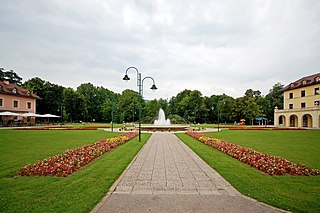
Ilidža is a town and a municipality located in Sarajevo Canton of the Federation of Bosnia and Herzegovina, an entity of Bosnia and Herzegovina. It has a total population of 66,730 with 63,528 in Ilidža itself, and is a chief suburb of Sarajevo and de facto its neighborhood. It is best known for the Vrelo Bosne spring, as well as the natural environment of its surroundings and historical tradition dating back to Neolithic times. Sarajevo International Airport is located nearby.

Stari Grad is a municipality of the city of Sarajevo, Bosnia and Herzegovina. It is the oldest and most historically significant part of Sarajevo. At its heart is the Baščaršija, the old town market sector where the city was founded by Ottoman general Isa-Beg Ishaković in the 15th century.
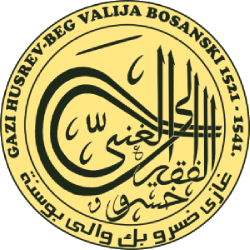
Gazi Husrev-beg was an Ottoman Bosnian sanjak-bey (governor) of the Sanjak of Bosnia in 1521–1525, 1526–1534, and 1536–1541. He was known for his successful conquests and campaigns to further Ottoman expansion into Croatia and Hungary. However, his most important legacy was major contribution to the improvement of the structural development of Sarajevo and its urban area. He ordered and financed construction of many important buildings there, and with his will bequeathed all his wealth into endowment for the construction and long-term support of religious and educational facilities and institutions, such as the Gazi Husrev-beg Mosque, and the Gazi Husrev-begova Medresa complex with a Gazi Husrev-beg Library, also known as Kuršumlija.

Gazi Husrev-beg Mosque is a mosque in the city of Sarajevo, Bosnia and Herzegovina. Built in the 16th century, it is the largest historical mosque in Bosnia and Herzegovina and one of the most representative Ottoman structures in the Balkans. Being the central Sarajevo's mosque since the days of its construction, today it also serves as the main congregational mosque of the Muslims in Bosnia and Herzegovina. It is located in the Baščaršija neighborhood in the Stari Grad municipality and, being one of the main architectural monuments in the town, is regularly visited by tourists.
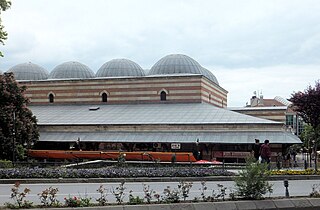
A bedesten is a type of covered market or market hall which was historically found in the cities of the Ottoman Empire. It was typically the central building of the commercial district of an Ottoman town or city, where the most important and precious goods were kept and sold. Its function was comparable or equivalent to that of a qaysariyya in other regions, though the architecture of the latter could be different and be similar to that of a bazaar with its own streets.

Türbe is the Turkish word for "tomb". In Istanbul it is often used to refer to the mausolea of the Ottoman sultans and other nobles and notables.

Baščaršija is Sarajevo's old bazaar and the historical and cultural center of the city. Baščaršija was built in the 15th century when Isa-Beg Ishaković founded the city.

The University of Sarajevo is a public university located in Sarajevo, Bosnia and Herzegovina. It is the largest and oldest university in the country, tracing its initial origins to 1537 as an Islamic madrasa.

Tourism in Bosnia and Herzegovina is a fast-growing sector making up an important part in the economy of the country.

Sanjak of Bosnia was one of the sanjaks of the Ottoman Empire established in 1463 when the lands conquered from the Bosnian Kingdom were transformed into a sanjak and Isa-Beg Isaković was appointed its first sanjakbey. In the period between 1463 and 1580 it was part of the Rumelia Eyalet. After the Bosnia Eyalet was established in 1580 the Bosnian Sanjak became its central province. Between 1864 and the Austro-Hungarian occupation of Bosnia in 1878 it was part of the Bosnia Vilayet that succeeded the Eyalet of Bosnia following administrative reforms in 1864 known as the "Vilayet Law". Although Bosnia Vilayet was officially still part of the Ottoman Empire until 1908 the Bosnian Sanjak ceased to exist in 1878.
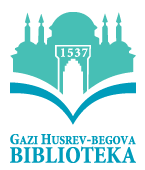
The Gazi-Husrev-beg Library is a public library in Sarajevo, Bosnia and Herzegovina founded in 1537 by the Ottomans, and is part of a larger complex with Gazi Husrev-beg Medresa. It holds one of the most important collections of Islamic manuscripts in Bosnia-Herzegovina, including many originally donated by Gazi Husrev-beg. The collection survived through Bosnian war and Siege of Sarajevo. The library also holds a sizable number of books, journals, newspapers, documents and photographs.
Hüsrev is a Turkish given name derived from the Persian name "Khusraw", having the same meaning.

The Aladža Mosque, also known as Šarena džamija, "Colorful Mosque", is an Ottoman era mosque that was built in 1549 and located in Foča, Bosnia and Herzegovina. It is considered one of the most beautiful and important examples of Ottoman architecture in Europe, and is one of the most important Ottoman era mosques in all of Bosnia and Herzegovina; along with the Gazi Husrev-beg Mosque in Sarajevo and the Ferhadija Mosque in Banja Luka. It was completely destroyed with pre-planted explovises at the beginning of the Bosnian War in 1992 by the VRS, and levelled to the ground; along with the left over stones and rubble from the mosque being hidden all over Foča to prevent its reconstruction. After many years of searching for the stones once the Bosniak refugees of Foča began to return, and sourcing the funds necessary for the reconstruction of the mosque, its reconstruction was started in 2016, and completed in 2018.
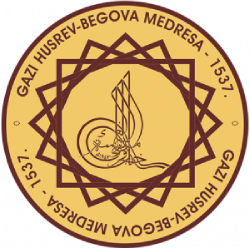
JU Gazi Husrev-begova medresa, Sarajevo is a high school and college, a madrasa in Arabic, founded on 8 January 1537 CE and built in Sarajevo as Gazi Husrev-beg's second endowment. It was built in the style of the Istanbul madrasas, and was called Kuršumlija because it was covered with a lead roof.

Gazi Husrev-beg's bezistan is one of the preserved bezistan in Sarajevo, Bosnia and Herzegovina, from the Ottoman period in the history of the country. Built in 1555 in Baščaršija, bezistan still serves its purpose - trade.

Gazi Husrev-beg's Hanikah is a hanikah in Sarajevo. Tesavuf was studied in hanikah, and today it has an artistic purpose.

The sacking of Sarajevo took place on 23 October 1697 and was committed by raiding Austrian troops led by Prince Eugene of Savoy. At this time the Great Turkish War was being fought. Shortly after the Austrian victory at the Battle of Zenta, an opportunity arose for the Austrians to launch a surprise attack into Ottoman Bosnia.
References
- 1 2 3 Dzirolo 1996.
- 1 2 3 4 5 6 7 8 9 10 11 12 13 14 15 16 17 Popovic 2007.
- 1 2 3 4 5 Britannica 1910.
- 1 2 3 4 5 6 7 "Bosnia and Herzegovina". Grove Encyclopedia of Islamic Art & Architecture. Oxford University Press. 2009. ISBN 9780195309911.
- ↑ ArchNet.org. "Sarajevo". Cambridge, Massachusetts, USA: MIT School of Architecture and Planning. Archived from the original on 6 January 2014. Retrieved 6 January 2014.
- 1 2 3 "Movie Theaters in Sarajevo, Bosnia and Herzegovina". CinemaTreasures.org. Los Angeles: Cinema Treasures LLC. Retrieved 6 January 2014.
- ↑ Stephen Pope; Elizabeth-Anne Wheal (1995). "Select Chronology". Dictionary of the First World War. Macmillan. ISBN 978-0-85052-979-1.
- 1 2 "Sarajevo", Webster's Geographical Dictionary, Springfield, Massachusetts, USA: G. & C. Merriam Co., 1960, p. 1008, OL 5812502M
- ↑ "Sarajevo (Bosnia and Hercegovina) Newspapers". WorldCat. USA: Online Computer Library Center . Retrieved 6 January 2014.
- ↑ "Bosnia and Herzegovina: Directory". Europa World Year Book. Taylor & Francis. 2004. ISBN 978-1-85743-254-1.
- 1 2 3 Christopher Markiewicz; Nir Shafir (eds.). "Hazine: a Guide to Researching the Middle East and Beyond" . Retrieved 30 January 2015.
- ↑ "Population of capital city and cities of 100,000 or more inhabitants". Demographic Yearbook 1955. New York: Statistical Office of the United Nations.
- ↑ "Quake Shakes Sarajevo; 7 in Yugoslav City Hurt", New York Times, 12 June 1962
- ↑ United Nations Department of Economic and Social Affairs, Statistical Office (1987). "Population of capital cities and cities of 100,000 and more inhabitants". 1985 Demographic Yearbook. New York. pp. 247–289.
- ↑ Riedlmayer, András (July 1995). "Erasing the Past: The Destruction of Libraries and Archives in Bosnia - Herzegovina" (PDF). Middle East Studies Association Bulletin. Middle East Studies Association of North America. 29: 7–11. doi:10.1017/S0026318400030418. S2CID 164940150 . Retrieved 6 January 2014.
- ↑ "Members". Global Investigative Journalism Network. Retrieved 6 January 2014.
- ↑ Markowitz 2007.
This article incorporates information from the German Wikipedia and Serbian Wikipedia.
